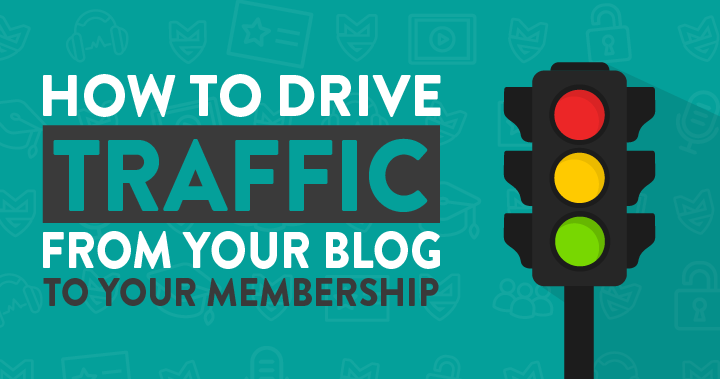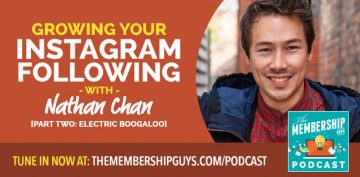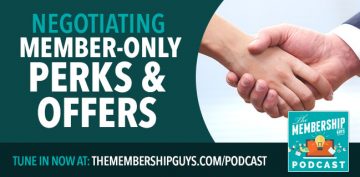Most online membership owners use content marketing as a means of attracting new members.
Sharing useful articles, podcasts or videos on their blog is a proven way to generate traffic, establish credibility and build the trust that will have your audience wanting more from you.
But how do you connect the dots between your blog and your membership, so that readers go on to become members?
Why is it important for your blog to link to your membership?
It’s not easy to drive traffic to your membership site, as it’s behind a paywall – not indexed by Google and not searchable as a result.
But it is easy to drive traffic to your membership from your blog content.
If your membership was a physical store, your blog is like the window everyone looks into.
If you can’t put on a good window display, nobody’s going to come into your shop and spend their money!
As a result, your blog is the prime place to promote your membership.
It’s the power of content marketing – and we want all membership site owners to know How To Use Content Marketing To Sell Your Online Membership.
That may seem obvious, however there are some internet marketers who will tell you not to promote or even mention your product to someone until you’ve drawn them into your sales funnel…
I’m going to be blunt here – that is nonsense.
Often all someone needs to feel ready to buy is awareness that you have a solution to their problem.
That’s why it’s essential to join the dots between your blog and your membership.
To do that, there are two main approaches you can take – the direct approach and the indirect approach.
Direct approaches
Let’s go through some of the direct approaches you can take to drive traffic from your blog to your membership:
CTAs and text links in your blog posts
Any time you refer to your membership or you have an opportunity to organically reference it, you should absolutely be linking to your membership website.
One of the best ways to organically refer to your membership in your content is to use your membership as a framing device.
For example, this podcast episode actually stemmed from a conversation inside our Membership Academy community.
One of our members asked this specific question in our forum – “how do I drive traffic from my blog to my membership sales page” – and it inspired this episode.
And… what do you know? I’ve just organically introduced the Membership Academy into this post with a lovely link attached to it!

Doing this and using your membership as a reference point in your content also enhances the quality of your content.
Letting your audience know that your content is based on real-life problems people face and is shared in relatable terms gives them more reason to consume it!
And, for bonus points, you’re also giving readers an insight into the content and activity that exists within your membership.
Make sure your membership is in your navigation menu
This might sound like an obvious idea, but many people are hesitant to do this.
Often, it’s because they’ve been told not to by an internet marketing ‘guru’ who believes solely in the power of sales funnels, or because they’re worried about coming off as salesy.
Selling your membership is not a sin!
Make sure people have the option to explore your membership via your navigation menu and your sidebar.
Nobody is going to be repulsed and horrified that you have presented that information to them and, as we mentioned earlier, sometimes all people need to become a customer is the awareness that your product or service exists.
Reference specific content or features in your membership
If you’ve covered a particular topic in your content and have a feature or piece of content in your membership that explores it in closer detail – make sure you let your audience know about it.
If you have a course, workshop, or checklist that sits within your membership that gives your audience the next step(s) after finishing your free content, that is a perfect opportunity to drop a natural and reasonable mention of your membership into the conversation.
We’ve talked many times before about a mentality with content marketing: That you should give away the ‘what’ and ‘why’, but you should sell the ‘how’.
For example, an article that explains the best vegetables to grow in a given month and why, but the seeds, growing calendar, and advice pack are all part of a subscription service.
If you’re not sure where to draw that line, we recommend taking a look at our post exploring How to Decide Which Content Should Be Free vs Paid
Link on your subscription thank you page
Can you name a better location to tell people about what your membership offers?
If someone has just subscribed to your email list, they have quite literally performed an action that shows that they want more of what you have to offer.
We’ve written entire articles about How to Generate Email Leads for Your Membership Site before – it’s that powerful!
You need to make sure you’re using that thank you page to make them aware of your membership.
Truly, this is one of the most underutilized locations for driving traffic and sales from a blog to a membership.
We get so many people clicking through from the CTA on our thank you page and we have so many members inside our community whose sales significantly increased once they added that CTA to their thank you pages as well.
Indirect approaches
There are also indirect approaches you can take that are just as effective, but use your blog as the starting point for driving that traffic to your membership site.
Email campaigns
If you’ve got an email list and subscribers to it, building a specific nurture sequence based around your membership is a must.
As we mentioned before, if people are subscribed to your emails – they want to know more about you and what you offer!
Within the content of your emails, you can use your membership as a framing device and you can use your members as examples (just as with your other content).
In addition to that, you can also include some much more direct emails that simply sell your membership.
There’s nothing wrong with that!
These emails can be built around specific features, case studies, and testimonials and results that link back to your membership.
If you’re part of Membership Academy, we have some copy and paste swipe files that you can utilize if you’re looking for some templates to use for nurture sequences like that (as well as for onboarding and engagement).
Facebook remarketing ads
Use targeted ads to reach the specific people who have visited your website and read your blog.
We’ve talked in depth about Facebook Remarketing Strategies for Membership Websites recently, so do take a look at that post if you want to learn more about the system.
In simple terms, Facebook remarketing lets you show ads to people based on whether they visited your site and what they did on it.
For example, if someone reads a blog post on a specific topic, you could show a remarketing ad that’s relevant to that topic, rather than a generic membership ad.
We have a whole course that goes into Facebook remarketing strategies for increasing sales and member retention in the Membership Academy if you’d like to learn more about this powerful tool for converting blog traffic into members.
Ensure your main site has links to your social media channels
Your social media channels aren’t the top priority – signups are much more valuable than follows, after all.
Even though there is certainly a hierarchy to the CTAs you use, driving people to your social channels and discussing your membership there is still an effective way to nurture that relationship and build that trust.
If your blog isn’t making someone immediately join your membership, that’s fine.
You have other avenues to pursue and your social media is one of the best – and easiest – to focus on.
Follow similar principles as in the other suggestions – share features, testimonials, and use cases from your membership in social posts and link through to your membership sales page on occasion.
Your blog is the central hub for your content
It’s important to remember that your membership site content is typically locked behind a paywall where search engines cannot reach it and you cannot link to.
As such, it’s much harder to drive traffic directly to your membership sales page.
However if you use your blog effectively, it can be the starting point of a journey that ultimately leads to people visiting and joining your membership.






